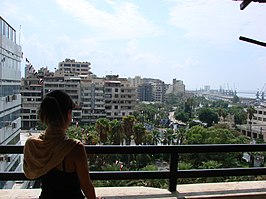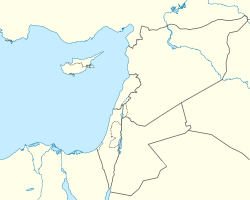
Back Latakia Afrikaans اللاذقية Arabic اللاذقيه ARZ Əl-Laziqiyyə Azerbaijani لاذقیه AZB Латакія Byelorussian Латакия Bulgarian লাতাকিয়া Bengali/Bangla Latakija BS Latakia Catalan
Latakia
ٱللَّاذْقِيَّة / ٱللَّاذِقِيَّة Laodicea | |
|---|---|
City | |
Downtown view • The governor's palace Port of Latakia • National Museum of Latakia Al-Assad Stadium • Latakia Sports City | |
| Nickname: "Bride of the Mediterranean"[1] | |
| Coordinates: 35°31′N 35°47′E / 35.517°N 35.783°E | |
| Country | |
| Governorate | Latakia Governorate |
| District | Latakia District |
| Subdistrict | Latakia Subdistrict |
| Founded | 4th Century BC[3] |
| Founded by | King Seleucus I Nicator |
| Government | |
| • Governor | Amer Ismail Hilal[4][5] |
| Area | |
| • Land | 58 km2 (22 sq mi) |
| • Metro | 108 km2 (42 sq mi) |
| Elevation | 11 m (36 ft) |
| Population (2023 Estimate) | |
| • City | 709,000[2] |
| • Metro | 709,000 |
| • Metro density | 6,600/km2 (17,000/sq mi) |
| Demonym(s) | Arabic: لاذقاني, romanized: Lādhqani |
| Time zone | UTC+2 (EET) |
| • Summer (DST) | UTC+3 (EEST) |
| Area code(s) | Country code: 963 City code: 41 |
| Geocode | C3480 |
| Climate | Csa |
| International airport | Bassel Al-Assad International Airport |
| Website | eLatakia |
Latakia (Arabic: ٱللَّاذْقِيَّة, romanized: al-Lādhiqiyya; Syrian pronunciation: [el.laːdˈʔɪjje, -laːðˈqɪjja]) is the principal port city of Syria and capital city of the Latakia Governorate located on the Mediterranean coast. Historically, it has also been known as Laodicea in Syria or Laodicea ad Mare. In addition to serving as a port, the city is a significant manufacturing center for surrounding agricultural towns and villages. According to 2023 estimate, the population of the city is 709,000,[6] its population greatly increased as a result of the ongoing Syrian Civil War, which led to an influx of internally displaced persons from rebel held areas. It is the 4th-largest city in Syria after Aleppo, Damascus, and Homs. It borders Tartus to the south, Hama to the east, and Idlib to the north, and Cape Apostolos Andreas, the north-eastern tip of Cyprus, is about 109 kilometres (68 mi) away.[7]
Although the site of the city has been inhabited since the 2nd millennium BC, the city was founded in the 4th century BC under the rule of the Seleucid Empire.[3] Latakia was subsequently ruled by the Romans and Byzantines, followed by the Rashiduns, Ummayads and Abbasids during the 7th–10th centuries AD. Byzantine ruling groups frequently attacked the city, periodically recapturing it before losing it again to Arab powers, particularly the Fatimids. Afterward, Latakia was ruled successively by the Seljuk Turks, Crusaders, Ayyubids, Mamluks, and the Ottomans. Following World War I, Latakia was assigned to the French mandate of Syria, in which it served as the capital of the autonomous territory of the Alawites. This autonomous territory became the Alawite State in 1922, proclaiming its independence a number of times until reintegrating into Syria in 1944.[8]
- ^ Hamsa. "Meshquita; treasure trove of sparkling springs and lush forests". syriatimes.sy. Archived from the original on 2 January 2018. Retrieved 27 March 2018.
- ^ [1] Archived 2023-02-17 at the Wayback Machine Macrotrends. “Lattakia, Syria Metro Area Population 1950-2023.”
- ^ a b Pandey, Akhil (2019-01-10). EURODASH79: The Quest - Inspired and Relentless Search for the True Knowledge, Culture & Values. Bloomsbury Publishing. ISBN 978-93-88134-59-0. Archived from the original on 2023-09-23. Retrieved 2021-02-14.
- ^ "President al-Assad issues decrees appointing new governors for four Syrian provinces". SANA. 2021-11-17. Archived from the original on 2021-11-17. Retrieved 2021-11-17.
- ^ H. Zain / Mazen / H. Sabbagh (23 April 2011). "New Governor of Lattakia sworn in". Syrian Arab News Agency. Archived from the original on 26 April 2011. Retrieved 23 April 2011.
- ^ "Macrotrends". Latakia Population. Macrotrends. Archived from the original on 2023-02-17. Retrieved 2023-02-17.
- ^ "Syrian swimmer crosses over waters between Cyprus, Syria". Archived from the original on 2016-10-11. Retrieved 2016-07-29.
- ^ Lefèvre, Raphaël (2013). Ashes of Hama: The Muslim Brotherhood in Syria. Oxford University Press. ISBN 978-0-19-933062-1. Archived from the original on 2023-09-23. Retrieved 2021-02-14.
© MMXXIII Rich X Search. We shall prevail. All rights reserved. Rich X Search









